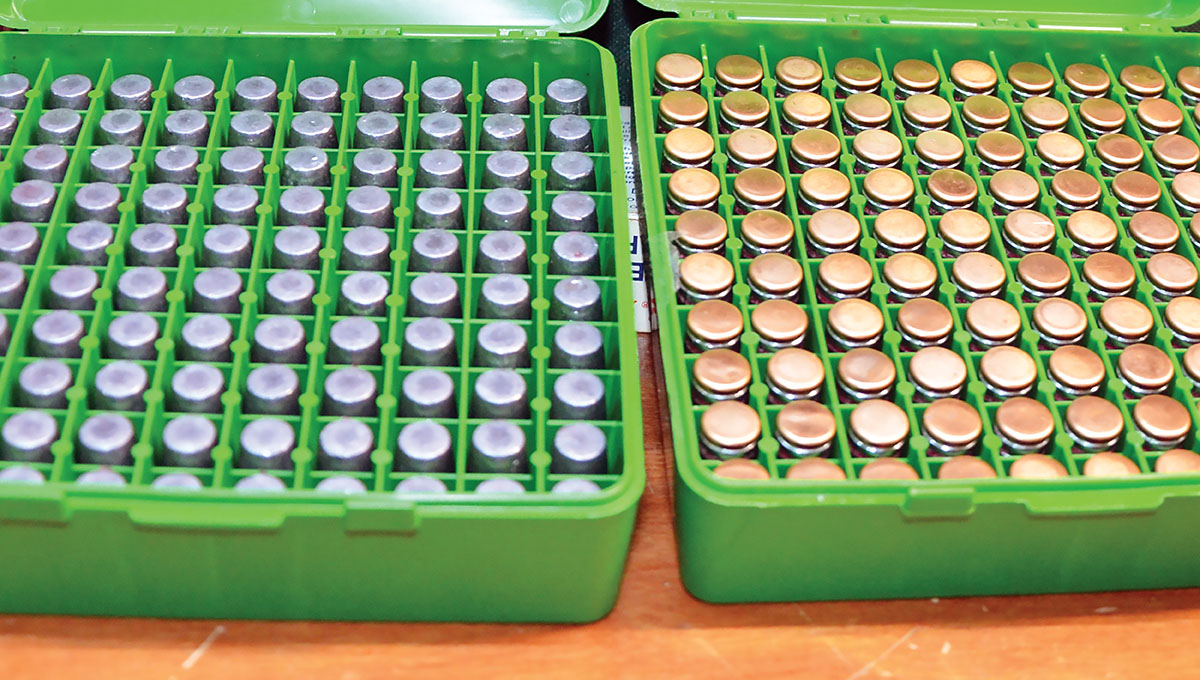
All bullets with gas checks come in reusable compartmented plastic boxes made by MTM Case-Gard. Those, as well as plain-base bullets in sturdy cardboard boxes, are packed so securely that they seldom suffer damage during USPS Priority Mail shipment.
I am not sure how many years I have enjoyed the excellent performance of lead-alloy bullets cast by the talented people at Rim Rock Bullets, Inc., of Polson, Montana, but it has been long enough to send thousands down range from many rifles and handguns of various calibers. Options in my loading room through the years have ranged from a 46-grain .224-inch bullet loved by my Marlin 1894 CL in 218 Bee to a 500-grain .500-inch bullet loaded in cartridges in the magazine of my custom Marlin 1895 in 50 B&M Alaskan. Many calibers and weights in between those two are available, with one of the most fun I have tried in my Henry Big Boy being the 115-grain .313-inch bullet, which is also ideal for the 32 H&R Magnum and the 32-20 Winchester. Before getting into handloads with some of the Rim Rock bullets, I have used through the decades, perhaps a bit of information on the company is in order.
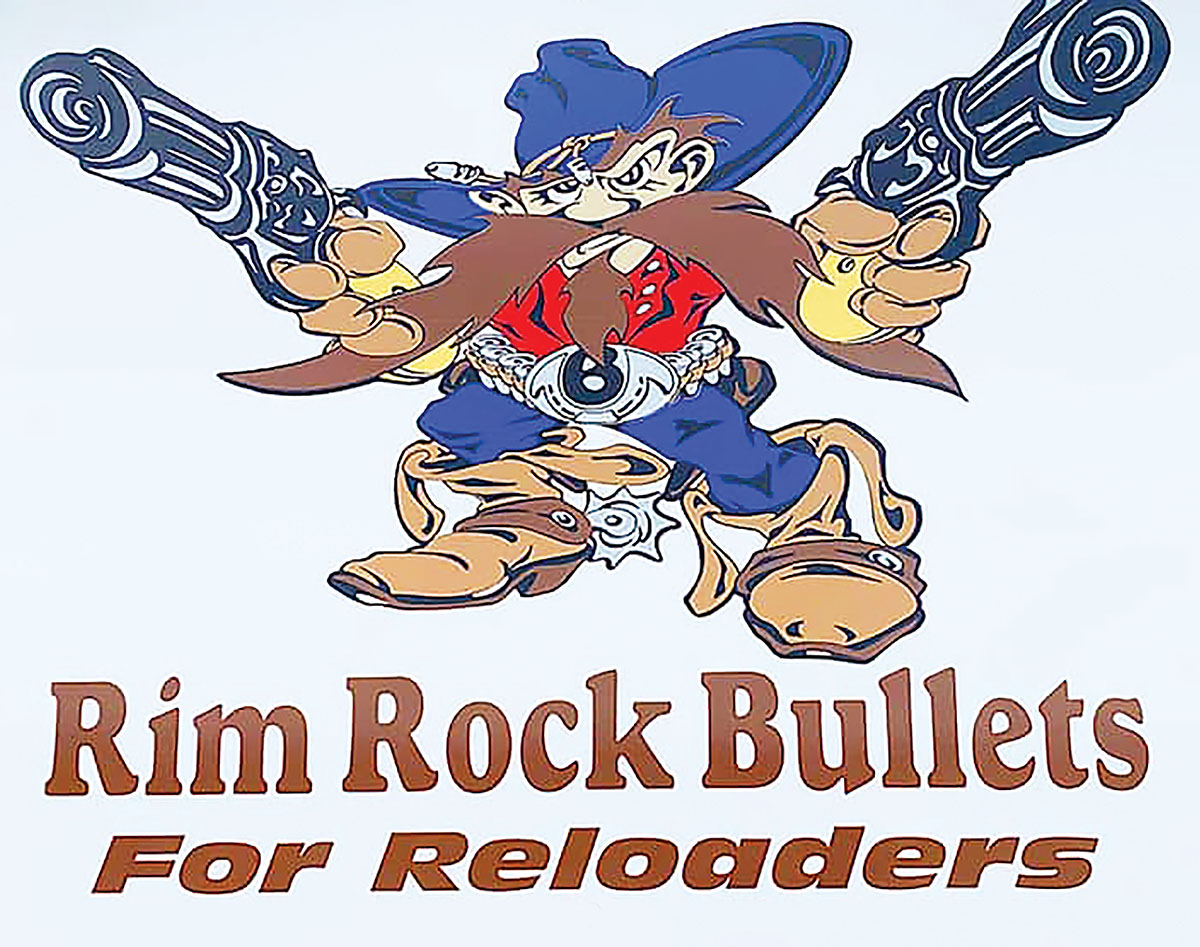
When Frank Brown and his son Frankie decided to get into the bullet-casting business in 2005, they hit the ground running by buying a small company not far from their hometown that was already doing just that. With it came an account to furnish bullets to Tim Sundles, owner of Buffalo Bore Ammunition, located just up the road. The company has grown quite a bit, and as of this time, 22 happy men and women are employed. About 50 percent of them are casters, while the others are pretty much evenly divided between those who lube bullets and those who do that, as well as fit gas checks. Over 200 sets of gang molds are on hand. Frank has put in his time and is now semi-retired, while Frankie stays busy managing the company. A very talented fellow, he designed and built some of the machines and other equipment used in various operations.
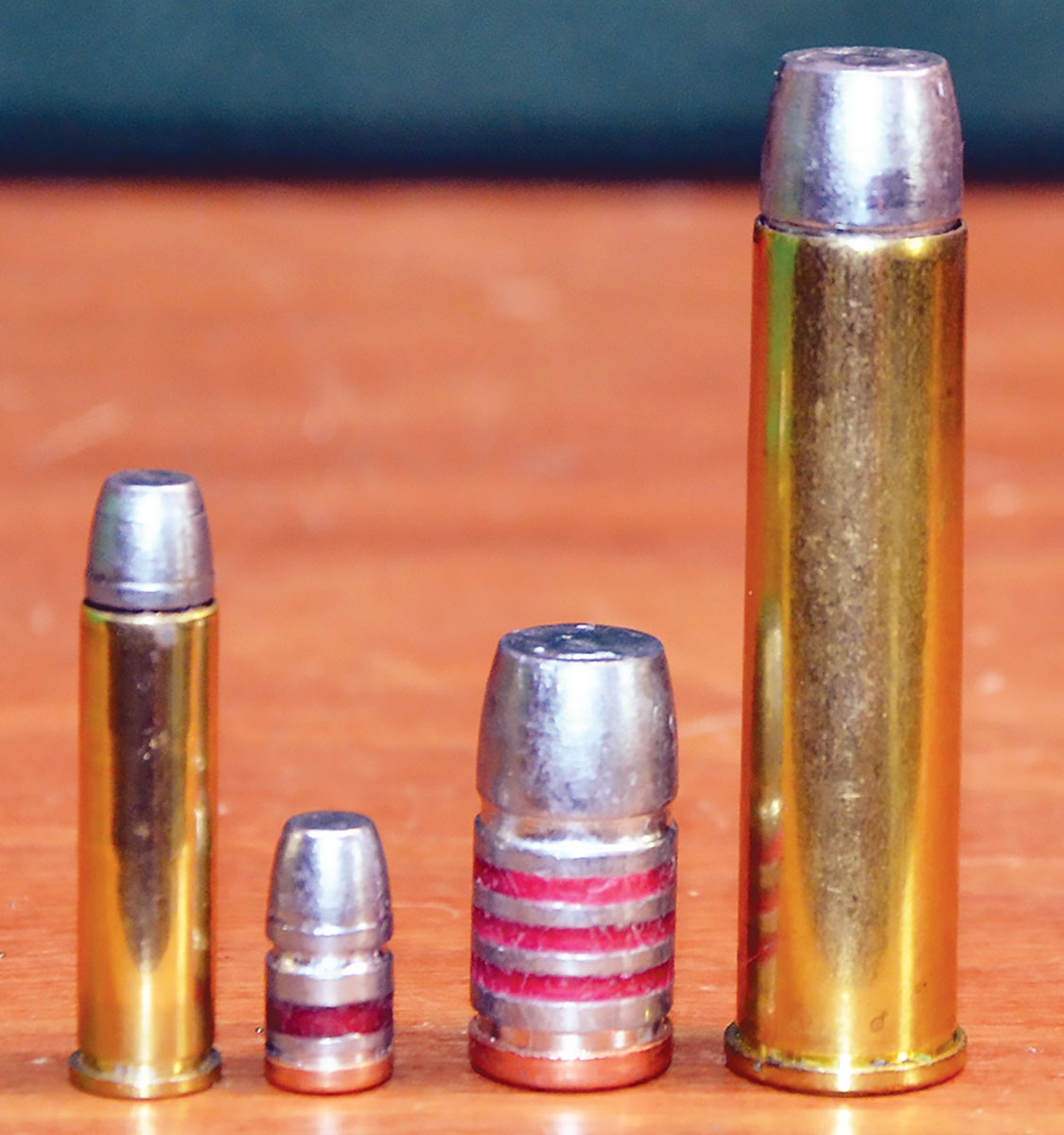
Big differences in bullet weights and diameters here illustrate the wide range of options offered by Rim Rock. The .32-caliber, 115-grain RNFP (left) is a favorite when loading the 327 Federal Magnum for my Henry Big Boy. The .50-caliber, 500-grain WFN (right) is a bullet I would not hesitate to use when hunting Alaskan brown bear with an SSK custom Marlin 1895 in 50 B&M Alaskan.
When it comes to production numbers and other pertinent details, the heads of most companies in the shooting industry are rather tight-lipped, but Frankie is not among them.
Each year, Rim Rock receives upward of one million pounds of lead in 50,000-pound batches, each batch alloy-mixed to Rim Rock Specifications. Brinell hardness number ratings of those batches range from 5 BHN to 22 BHN (more on this later). Year-to-year annual production varies, but it has exceeded 40 million bullets. More than two tons of bullet lube is used each year.
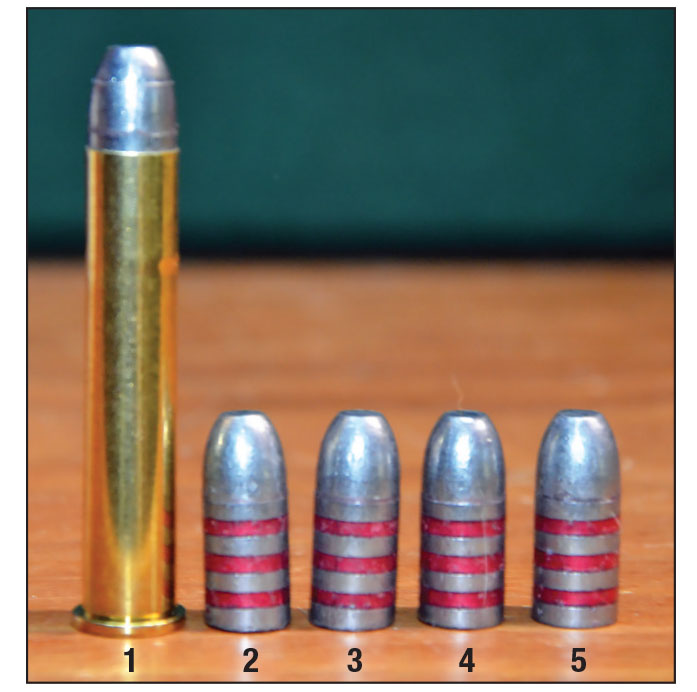
Due to a wide range in barrel groove diameters of rifles and revolvers chambered for some cartridges, some Rim Rock bullets are available in several diameters. The Top Shelf 240-grain bullet for the 38-55 Winchester shown here is offered in four diameters ranging from .377 to .380 inch. Slugging the barrel of my Marlin 336 Cowboy revealed a groove diameter of .376 inch, and the 377-inch bullet proved to be right for it. Bullets include: (1) 38-55 loaded with the .377-inch bullet, (2) .377-inch bullet, (3) .378-inch bullet, (4) .379-inch bullet and (5) .380-inch bullet.
A most unusual production strategy pays off in uniformity, quality and customer delivery. Several casting machines are devoted to producing one particular bullet, (sometimes as long as 10 days) until a million or so of that bullet are in the warehouse. Those machines are then switched to producing a million of other bullet styles. Casting in this manner results in huge batches of bullets that are quite consistent in weight, hardness and diameter. Maintaining such large inventories also ensures timely delivery, whether to an individual customer or commercial clients who purchase thousands of bullets each year.
As seen on the Rim Rock website (RimRockBullets.com), several different categories of bullets are offered. As the name indicates, Cowboy bullets are popular with those who don 50-gallon hats and hand-tooled leather boots, and exchange tall tales while competing with Old West revolvers and rifles. Thousands of those bullets are also purchased by customers who have more interest in casual target shooting and weekend plinking sessions with the kids than competitive shooting. Brinell hardness numbers range from 12 BHN, recommended for velocities ranging up to 1,300 feet per second (fps), to 15 BHN, good up to 1,500 fps in barrels with decent bores. The SPG lubed bullets are for black-powder loads in the 38-40 Winchester, 44-40 Winchester, 44 Special, 45 Schofield, 45 Colt and others. The 525-grain Postell is for long-distance competitive shooting with single-shot rifles chambered for the 45-70, 45-90 and other big cartridges loaded with black powder.
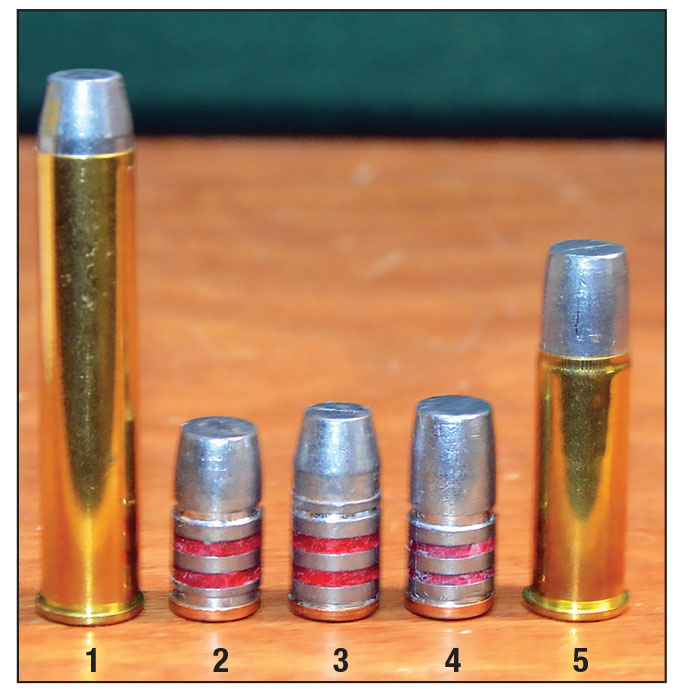
The Rim Rock .44-caliber 305- and 335-grain bullets are excellent choices for the slightly shortened 444 Marlin case but due to a longer distance between the crimp groove and nose of the 340-grain bullet, it will not work in that cartridge. All three bullets work fine in 44 Magnum loads for the Ruger Super Redhawk, Ruger Super Blackhawk, Colt Anaconda and other revolvers with cylinders long enough to handle it. Bullets include: (1) 444 Marlin loaded with the 335-grain bullet, (2) 305-grain bullet, (3) 335-grain bullet, (4) 340-grain bullet and (5) 44 Magnum loaded with the 340-grain bullet.
Some of the hollowpoint bullets have ratings between 5 BHN and 12 BHN for shooters who desire as much expansion as possible. A classic example at 12 BHN is the .44-caliber, 240-grain SWCHP, available for handloading, and 44 Magnum +P ammunition available from Buffalo Bore. With a nose cavity measuring .300-inch deep and .170-inch in diameter, it is honestly described by both companies as the Deer Grenade. A 180-grain version is also available. Other SWCHP options with the same hardness rating are 225- and 260-grain bullets for the 45 Colt. The softest of the bunch at 5 BHN is a 158-grain SWCHP, which expands when fired from snub-nosed revolvers in 38 Special. The Hard Cast, Top Shelf and most of the Gas Check categories of bullets range from 12 BHN to 22 BHN, with the latter recommended for velocities up to 2,200 fps from good barrels.
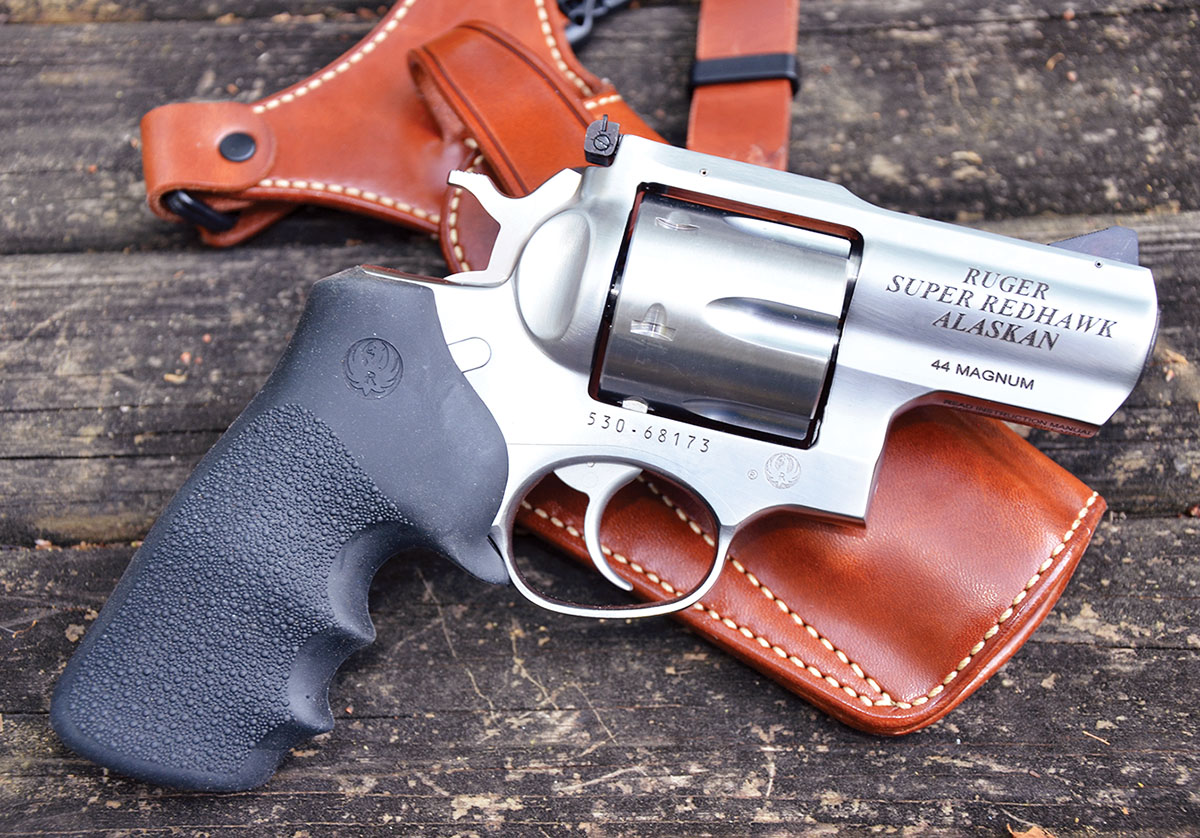
The cylinder of the Ruger Super Redhawk Alaskan in 44 Magnum I carry in bear country is long enough to handle ammunition loaded with any bullet of the caliber offered by Rim Rock, and for this reason, my pick is the 340-grain version due to its wide, flat nose. The Galco Great Alaskan cross-draw chest holster does a good job of retaining the gun in the rugged outdoors while making gun draws convenient.
Due to the wide range of barrel groove diameters of rifles and revolvers chambered for some cartridges, some bullets are available in several diameters. A good example is the Top Shelf 240-grain bullet offered in four diameters ranging from .377 to .380 inch for the 38-55 Winchester. Slugging the barrel of a rifle will determine which to try. For example, my Marlin 336 Cowboy measures .376 inch, and the Rim Rock .377-inch bullet is right for it. Moving to the opposite extreme, a friend’s vintage Winchester 94 delivers its best accuracy with the .380-inch bullet. Rim Rock makes it easy to try several diameters by currently charging $15 per pound for any available bullet, including shipping. In other words, for $30, you could shoot 29 bullets in each of two different diameters in that faithful old bear thumper in 38-55 Winchester. Before leaving the important subject of money, there is no shipping charge for regular internet purchases exceeding $160. All bullets with gas checks come in reusable compartmented plastic boxes made by
MTM Case-Gard. Those, as well as plain-base bullets placed in sturdy cardboard boxes, are packed so securely that they seldom suffer damage during USPS Priority Mail shipment.
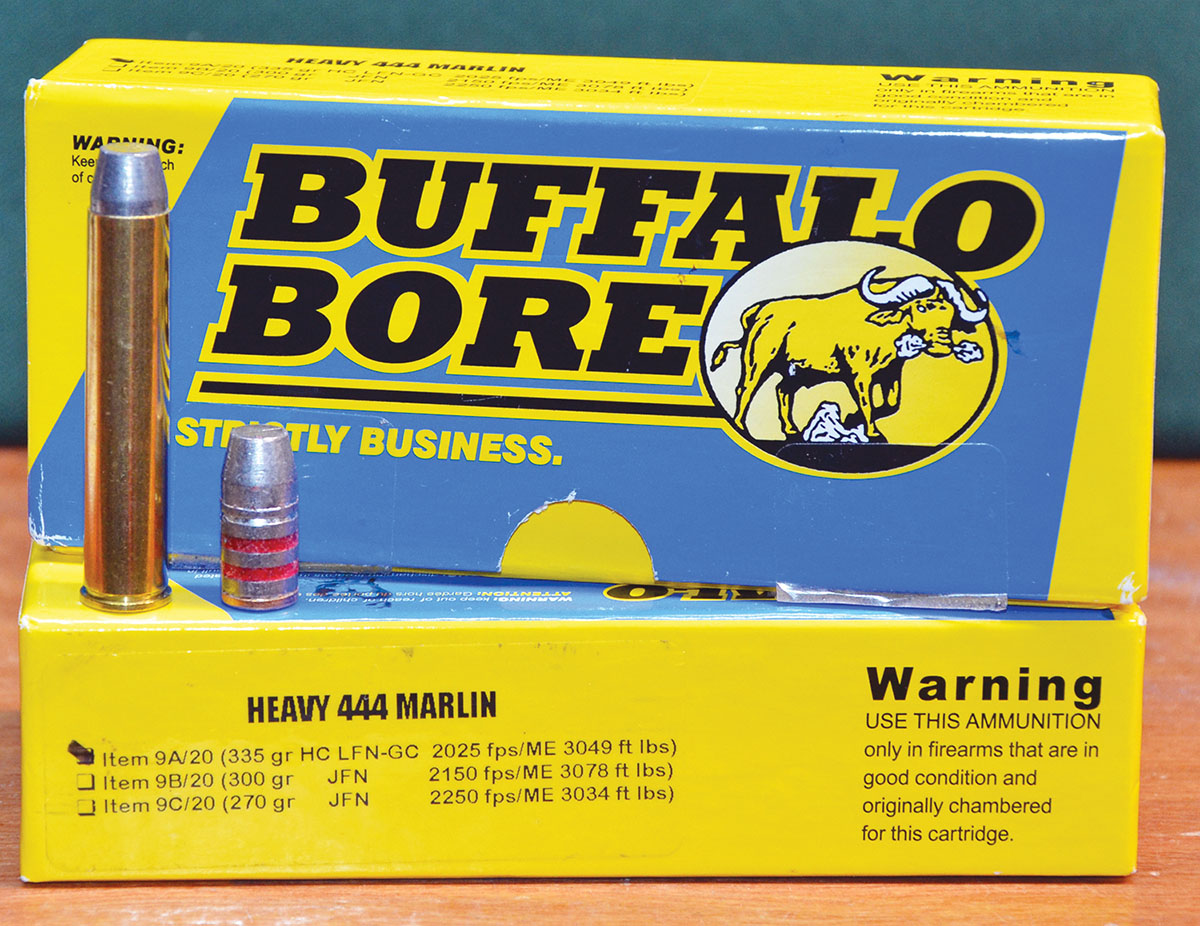
In its “Heavy” lineup of ammunition, Buffalo Bore Ammunition offers the 444 Marlin loaded with the Rim Rock 335-grain bullet at 2,025 fps for just over 3,000 foot-pounds of muzzle energy.
One tidbit of useful information shown for each bullet on the Rim Rock website is the distance from the crimp groove to the nose. This will tell you whether or not the cartridge overall length with a particular bullet will work in your gun or guns prior to placing an order. For example, the .44-caliber, 335-grain TCFN bullet measures .436 inch from nose to cannelure. While that particular bullet was designed for the 444 Marlin and is what Buffalo Bore loads in that cartridge, for some applications, it is quite good in the 44 Magnum as well. If your 44 Magnum cases are, say, 1.280 inches long, the overall cartridge length with the 335-grain bullet will be in the neighborhood of 1.715 inches. The Ruger Super Blackhawk, Ruger Super Redhawk, Colt Anaconda and several others easily handle this. Moving down a bit in caliber to the 41 Magnum, those dimensions for the 230-grain and 265-grain bullets are .630 and .705 inch, respectively, for cartridge overall lengths that are compatible with my faithful old Ruger Redhawk.
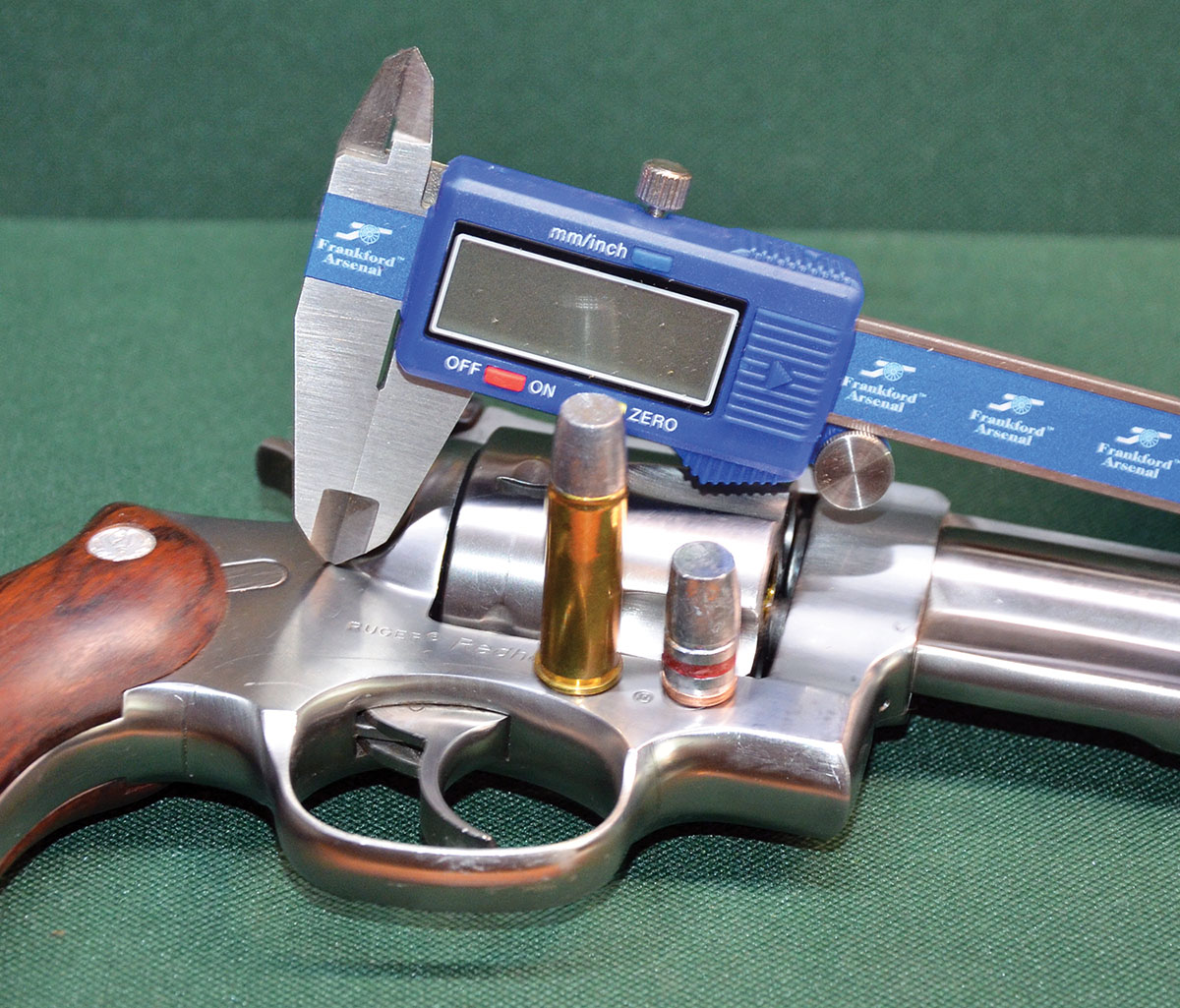
One tidbit of useful information shown for each bullet on the Rim Rock website is the distance from the crimp groove to the nose. This will tell you whether or not the cartridge overall length with a particular bullet will work in your gun or guns prior to placing an order. For example, for the 41 Magnum, the dimensions for the 230- and 265-grain bullets for the 41 Magnum are .630 and .705 inch, respectively, for cartridge overall lengths that are compatible with my Ruger Redhawk. Shown here is the 265-grain bullet and a round loaded with it.
Some Rim Rock bullets have interesting stories to tell. The Buffalo Bore +P loading of the 9mm Luger with the Rim Rock 147-grain hard-cast, flatnose bullet at 1,100 fps received a lot of publicity back in 2016, when Alaskan outfitter and guide Phil Shoemaker successfully protected two of his fishing clients from a grizzly attack. If the name sounds familiar, he used to write for various Wolfe publications. While guiding photographers and anglers, Phil usually carries a 44 Magnum revolver, but on that particular day, he decided to go light with a 9mm pistol. Long story short, the angry bruin had moved within three feet of Phil’s two clients when he placed a bullet into its neck. Unable to hit the bear in the head due to its movement, he placed another five bullets each time any other vital area was presented and put the 7th bullet into its pelvis area as it turned away. After stumbling along for about six feet, the bear dropped. According to Shoemaker, he had experienced many close encounters with bears but prior to that incident, he had never had to shoot an unwounded bear to protect either himself or his clients.
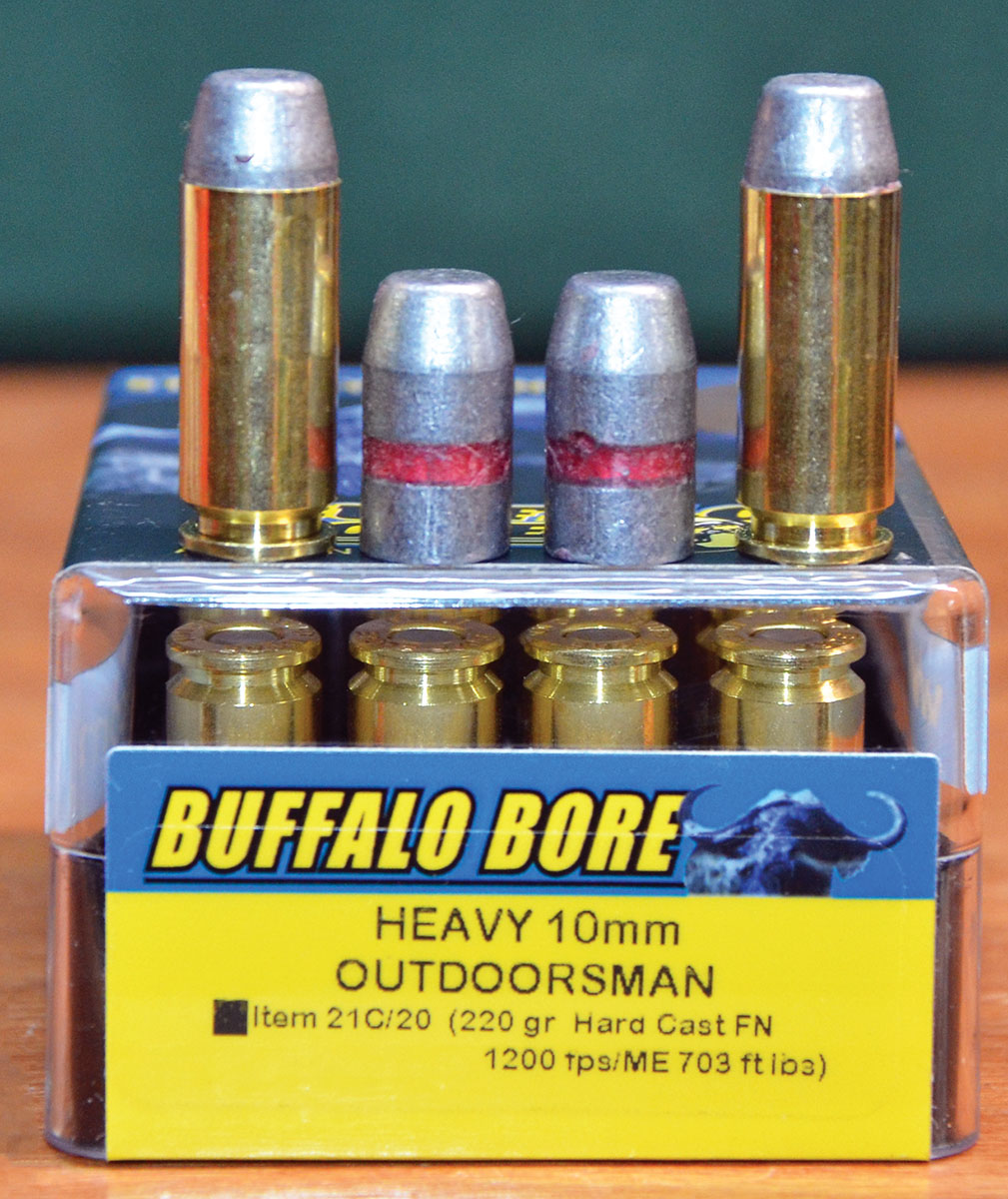
High-capacity pistols in 10mm Auto, such as the Glock G20 and Springfield Armory XD-M Elite, charged with Buffalo Bore ammunition loaded with the Rim Rock 220-grain, hard-cast, flatnose bullet, have become popular among those who carry a handgun when working, camping, fishing, hiking, berry-picking, mountain biking and other activities in bear country. Through the years, Buffalo Bore owner Tim Sundles has received reports from those who successfully used his ammunition while defending themselves against bear attacks.
Speaking of bears, the Glock G20 in 10mm Auto introduced in 1990 and charged with 16 rounds of Buffalo Bore ammunition loaded with the Rim Rock 10mm 220-grain hard-cast, flatnose bullet has long been popular among those who carry a handgun when working, camping, fishing, hiking, berry-picking, mountain-biking and other activities in bear country. Through the years, Buffalo Bore owner Tim Sundles has received reports from those who successfully used his ammunition while defending themselves against bear attacks. One law enforcement official reported five kills on nuisance moose and six on grizzlies with a Glock pistol and Buffalo Bore ammunition.
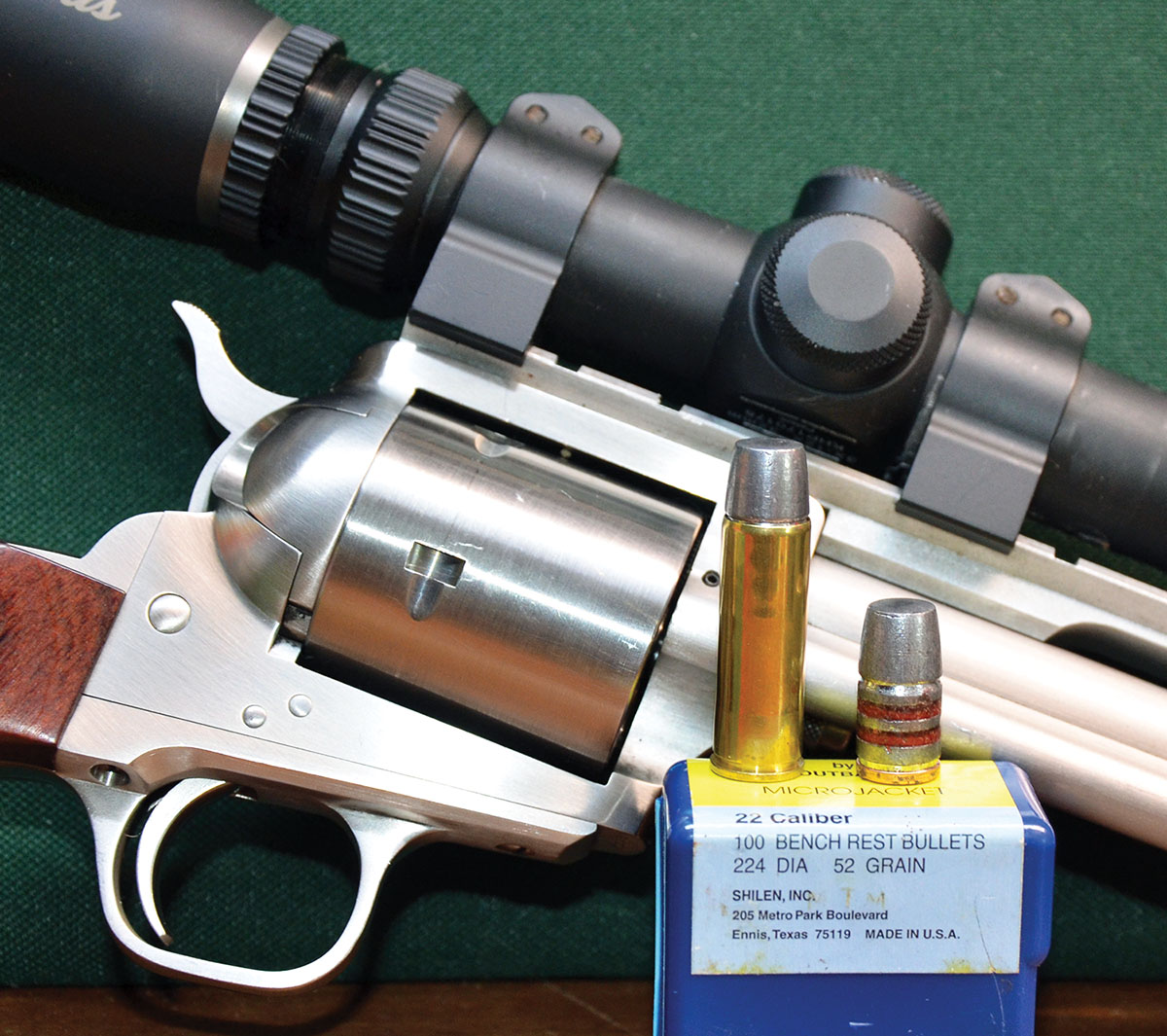
My Freedom Arms revolver in 454 Casull shoots 3-inch groups at 100 yards with a handload that pushes the Rim Rock 360-grain WFN bullet to a velocity of 1,500 feet per second. The combination is powerful enough to handle any game in North America.
Through the decades, I have spent many weeks in bear country, and when not armed with a rifle, I carried a Super Blackhawk Predator with a 45⁄8-inch barrel charged with Buffalo Bore ammunition loaded with the Rim Rock 305-grain hard-cast bullet. It was also a welcome bunk mate during nighttime with nothing but the thin wall of a tent between me and the Alaskan wilderness. Not long back, I switched to a Ruger Super Redhawk Alaskan with a 21⁄2-inch barrel weighing the same as the custom Ruger Super Blackhawk because I think a double-action revolver might be better than single-action for personal defense use. From the short barrel of that revolver, Buffalo Bore Heavy +P+ ammunition loaded with the Rim Rock 340-grain hard-cast, flatnose bullet clocks just over 1,200 fps and should penetrate deeply while delivering a heavy punch. In addition to warning that the ammunition should not be used in Smith & Wesson revolvers, the Buffalo Bore website lists revolvers that can be used.
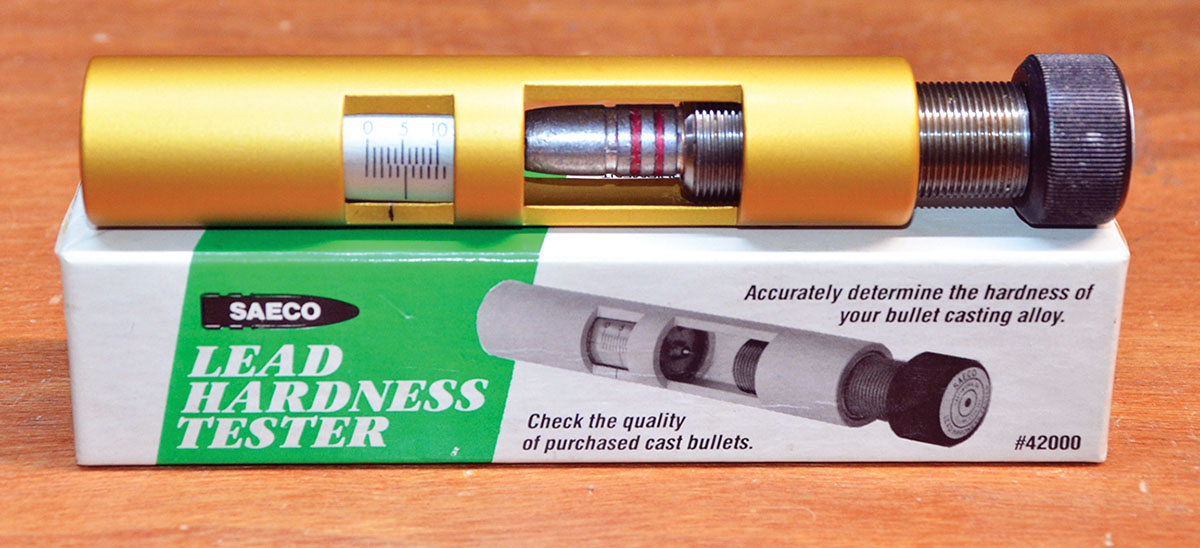
Rim Rock cast bullets are available in hardness ratings ranging from 5 BHN to 22 BHN, with the former being about the same as for lead. The latter is about the same as linotype and recommended for velocities up to 2,200 fps in a barrel with good bores.
While on the subject of .44-caliber, I will mention that in order for a 444 Marlin cartridge to successfully turn the corner and enter the magazine of the Marlin rifle as it is being pushed through the loading gate, heavy cast bullets with long noses have to be seated to a specific overall cartridge length. With the Rim Rock 305-grain bullet loaded to a length of 2.540 inches it won’t make the turn, but seat it 0.020 inch deeper in the case and it slips right into the Marlin magazine. Slight differences in nose length and meplat diameter also matter; the 335-grain Rim Rock, with its smaller nose flat, feeds smoothly at 2.540 inches. Shortening cases to 2.120 inches for the 305-grain bullet and 2.085 inches for the 335-grain bullet aligns the mouth of the case with the crimp groove of the bullet when seated to those required cartridge lengths. Keep in mind that shortening cases decreases capacity and should be kept separate from full-length cases. Buffalo Bore Heavy 444 Marlin ammunition is loaded with that same 335-grain bullet at a cartridge length of 2.540 inches, and rather than using a shortened case, its mouth is given an extremely hard crimp forward of the crimp groove of the bullet. Bullet movement in the tubular magazine during recoil is avoided by using a compressed charge of powder.
As a final note, the 25-35 Winchester cases listed in Table I were formed by necking down Starline 30-30 Winchester cases, and the 32 Winchester Special cases were formed by necking up those cases. Redding case-sizing wax was used.
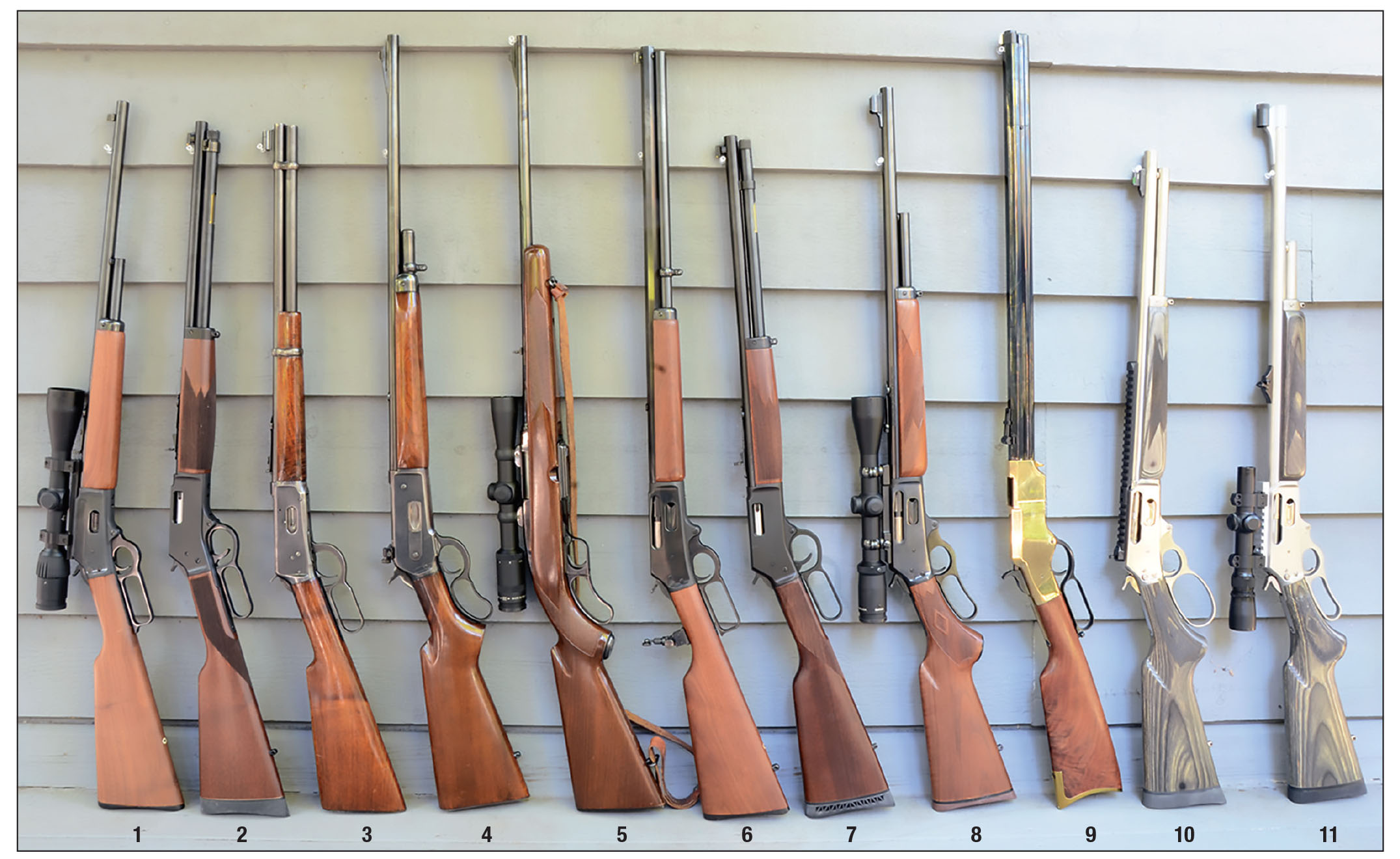
A few of the rifles Layne has shot through the years with handloaded Rim Rock bullets: (1) Marlin 1894 CL, 218 Bee, (2) Henry Big Boy, 327 Federal Magnum, (3) Winchester 94, 32 Winchester Special, (4) Winchester 71, 348 Winchester, (5) Winchester 88, 358 Winchester, (6) Marlin 336 CB, 38-55 Winchester, (7) Henry Big Boy, 41 Magnum, (8) Marlin 444SS, 444 Marlin, (9) Henry 1860, 44-40 Winchester, (10) Ruger-Marlin 1895 SBL, 45-70 and (11) SSK Industries Marlin 1895, 50 B&M Alaskan.
.jpg)












.jpg)
.jpg)
.jpg)


